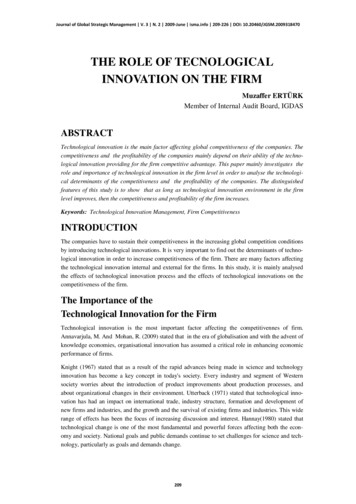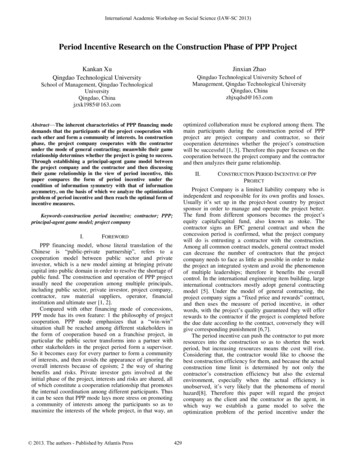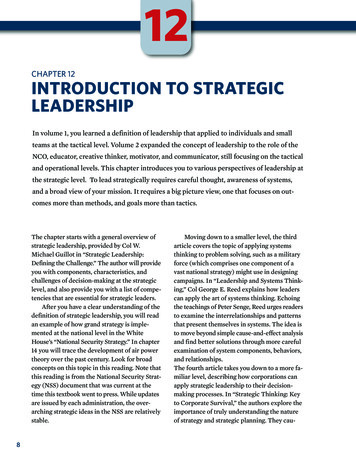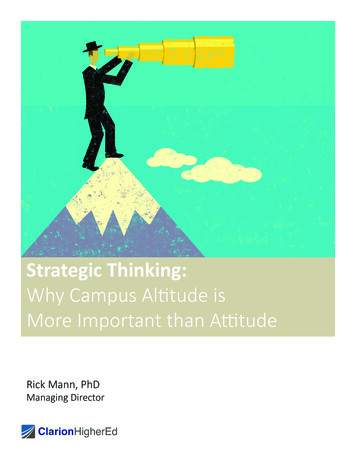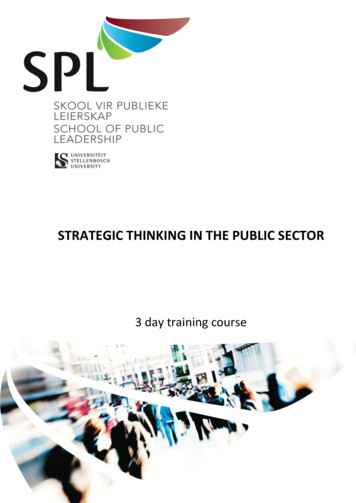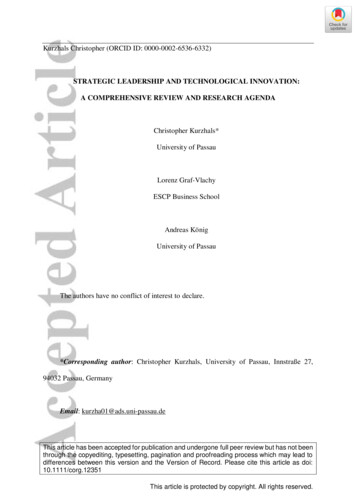
Transcription
Kurzhals Christopher (ORCID ID: 0000-0002-6536-6332)STRATEGIC LEADERSHIP AND TECHNOLOGICAL INNOVATION:A COMPREHENSIVE REVIEW AND RESEARCH AGENDAChristopher Kurzhals*University of PassauLorenz Graf-VlachyESCP Business SchoolAndreas KönigUniversity of PassauThe authors have no conflict of interest to declare.*Corresponding author: Christopher Kurzhals, University of Passau, Innstraße 27,94032 Passau, GermanyEmail: kurzha01@ads.uni-passau.deThis article has been accepted for publication and undergone full peer review but has not beenthrough the copyediting, typesetting, pagination and proofreading process which may lead todifferences between this version and the Version of Record. Please cite this article as doi:10.1111/corg.12351This article is protected by copyright. All rights reserved.
AUTHOR BIOGRAPHIESChristopher Kurzhals is a doctoral student at the University of Passau. Prior to hisdoctoral studies, he worked as a Consultant for the Boston Consulting Group. He obtained hisMaster in Banking and Finance from the University of St. Gallen. He also studied in the MBAprogram of the Chinese University in Hong Kong and at ESADE University in Barcelona. Hisresearch interests include strategic leadership, corporate governance, innovation, anddiscontinuous technological change.Lorenz Graf-Vlachy is Professor of Strategy at ESCP Business School in Berlin. Hiswork has been published in, for example, the Academy of Management Review, OrganizationScience, and the Journal of Management. Before his academic career, he was a Project Leaderat the Boston Consulting Group and a Project Manager at the World Economic Forum. Heholds a master’s level degree in Information Systems and a doctoral degree from FriedrichAlexander-University (FAU) Erlangen-Nuremberg as well as a habilitation from the Universityof Passau.Andreas König is Chaired Professor of Strategic Management, Innovation, andEntrepreneurship at the University of Passau and Visiting Professor at Free UniversityAmsterdam. His research focuses on discontinuous organizational transformation, strategicleadership, and executive communication and has appeared, for example, in AdministrativeScience Quarterly, Academy of Management Review, and the Academy of ManagementJournal. He earned his doctoral degree at the University of Erlangen-Nuremberg. He also holdsan MBA from HHL Leipzig, a Bachelor in Music from the Rotterdam Conservatoire, and aMaster of Music in trumpet performance from the Royal Academy of Music, London.Acknowledgments: We are grateful to editor Till Talaulicar and two anonymousreviewers for their invaluable feedback and guidance.This article is protected by copyright. All rights reserved.
STRATEGIC LEADERSHIP AND TECHNOLOGICAL INNOVATION:A COMPREHENSIVE REVIEW AND RESEARCH AGENDAResearch Question/Issue: We review the literature on the relationship between strategicleadership and technological innovation.Research Findings/Insights: We identify the theoretical lenses that researchers apply whenstudying strategic leadership and innovation, most notably agency theory and upper echelonstheory. We review the innovation constructs and measures that scholars employ, and we surveythe links among strategic leaders’ characteristics and technological innovation. Ultimately, weorganize the literature into an integrative framework that provides a concise overview of theextant knowledge and we outline an agenda for future research.Theoretical/Academic Implications: First, we offer scholars a discipline-spanningoverview of the extant knowledge on the topic. Second, by integrating important aspects ofcorporate governance, such as the role of the board of directors, incentives for the chiefexecutive officer or the top management team, and firm ownership, into the context oftechnological innovation, we highlight the vital role it plays in the realm of technologicalinnovation. Third, we provide a useful guide for scholars and direct their work towards fruitfulavenues for future research.Practitioner/Policy Implications: We offer insights for practitioners interested in betterunderstanding the bidirectional relationship between strategic leadership and technologicalinnovation. In particular, our framework and our detailed analysis of the impact of strategicleaders on technological innovation can guide shareholders and board members in mattersrelated to board composition as well as top executive selection and compensation.Keywords: Board of directors, chief executive officer (CEO), innovation, strategicleadership, technology, top management teamThis article is protected by copyright. All rights reserved.
INTRODUCTIONScholars have long sought to understand technological innovation (Ahuja, Lampert, & Tandon,2008; Dosi, 1982; Schumpeter, 1942; Teece, 1996), which can be broadly defined as changesin the ways value is created and captured in a given field (Damanpour, 1987; Hill &Rothaermel, 2003). Such changes include both discontinuous technological breakthroughs andincremental progress (Anderson & Tushman, 1990; Dewar & Dutton, 1986). Technologicalinnovation is vital for the survival of companies because, without it, firms are unlikely togenerate a sustainable competitive advantage (Hill & Rothaermel, 2003; Tripsas & Gavetti,2000). The ability to adopt technologies is particularly important considering today’s rapidtechnical advances, which in turn trigger grand challenges and opportunities (Tidd & Bessant,2018).Not surprisingly, given the key role of technological innovation, researchers haveincreasingly focused on the impact of strategic leaders—those executives who, as members ofthe board of directors or the top management team (TMT), are particularly influential(Finkelstein, Hambrick, & Cannella, 2009). Upper echelons theory suggests that strategicleaders affect organizational outcomes in general and innovation in particular (Hambrick &Mason, 1984), especially, because they influence organizational attention, resourcecommitment, strategic choices, and implementation strategies (Carpenter, Geletkanycz, &Sanders, 2004; Gerstner, König, Enders, & Hambrick, 2013; Kaplan, 2008a). In this vein,researchers in various disciplines, including corporate governance (e.g., Rose, Rose, Norman,& Mazza, 2014), strategic management (e.g., Kor, 2006), finance (e.g., Ammann, Horsch, &Oesch, 2016), and entrepreneurship (e.g., Gedajlovic, Cao, & Zhang, 2012), have studied therelationship between strategic leaders and innovation, creating a need to consolidate the currentstate of knowledge.This article is protected by copyright. All rights reserved.
Scholars have conducted valuable reviews in the field of innovation, including reviews ofliterature on the role of leadership. However, the limited reach of these reviews hasramifications for the analytic, predictive, and normative potential of research in this domain.Three limitations are particularly noteworthy. First, several broad reviews of the innovationliterature identify managerial characteristics as one of several antecedents of technologicalinnovation (Ahuja et al., 2008) or technological discontinuities (Eggers & Park, 2018), but theyhardly discuss the paths of influence. Second, some reviews offer outdated and incompleteoverviews of the relevant characteristics of strategic leaders. For example, Crossan andApaydin (2010) investigate the impact of the board and the TMT on innovation. However, thatreview is a decade old and only captures a small subset of the relevant characteristics ofstrategic leaders. Third, some reviews only link certain strategic leaders with specificinnovation outcomes. For example, Back and Bausch (2019) examine the impact of CEOleadership on various firm-level antecedents of product innovation, such as social capital. Yet,they do not consider a substantial number of studies that directly link CEO characteristics totechnological innovation more broadly and they do not consider strategic leaders other than theCEO. As such, no comprehensive review on strategic leadership and technological innovationis available, making it difficult for scholars to build on previous findings and identify relevantresearch questions.Our review fills this gap. We aim to answer four interrelated questions: (1) What are themain theoretical lenses that scholars have applied when exploring the relationship betweenstrategic leadership and technological innovation?, (2) Which constructs and measures oftechnological innovation have scholars combined with certain facets of strategic leadership?,(3) How are the characteristics of strategic leaders empirically related to different aspects ofinnovation?, and (4) What are potentially fruitful avenues for future research?.METHODThis article is protected by copyright. All rights reserved.
To ensure a comprehensive account of the literature, we conducted a systematic review (e.g.,David & Han, 2004; Rousseau, Manning, & Denyer, 2008). Given the multidisciplinary natureof the domain, we first identified 35 relevant peer-reviewed journals from different fields.These included the 30 outlets used in Wowak, Gomez-Mejia, and Steinbach’s (2017) recentreview of incentives in strategic leadership. To specifically capture corporate-governanceaspects, we also included a leading journal focused on that topic. In addition, due to the focusof this review, we included two journals concerned with innovation, which two innovationscholars confirmed were the most important in the field. Finally, we included two majorjournals dealing with family firms, as family firms are one of the most prevalent firm types (LaPorta, Lopez-De-Silanes, & Shleifer, 1999; Lodh, Nandy, & Chen, 2014). Moreover, familyownership and family involvement in strategic decision making substantially affect firms’technological innovation (De Massis, Frattini, & Lichtenthaler, 2013; Lodh et al., 2014). Infact, as De Massis et al. (2013, p. 10) note, “there are strong theoretical reasons to believe thatthe antecedents and effects of technological innovation are different in family and nonfamilyfirms.” Again, we validated our selection with two family business scholars. Table 1 providesan overview of the journals included in our review.Using the above-mentioned definitions of strategic leadership and technological innovationas our conceptual anchors, we created a list of keywords. To validate our selection of keywords,we discussed them with management and innovation scholars and consulted scholars fromeconomics and finance. These discussions led to the addition of a few keywords to our initiallist. Table 2 shows the final list of keywords used in our literature search.We set the review’s starting point to 1984 to cover all literature published after Hambrickand Mason’s (1984) seminal paper, which highlighted the importance of strategic leaders fororganizational outcomes and laid the foundations for upper echelons theory. We then identifiedThis article is protected by copyright. All rights reserved.
an initial sample of 937 articles published before the end of 2019 using the Web of Sciencedatabase.We read all articles’ abstracts and, if necessary, their main texts and retained those articlesthat fulfilled two criteria. First, each article had to examine strategic leaders (i.e., boards ofdirectors, CEOs, other TMT members, and/or business unit heads) (Finkelstein et al., 2009).Second, each article had to focus on technological innovation (Damanpour, 1987). Weremoved articles in which the hypotheses or propositions were not related to both criteria.Moreover, we removed articles dealing with young firms and start-ups due to the specificcontext in which these firms and their strategic leaders operate (e.g., Park & Tzabbar, 2016).Overall, we retained 158 articles and systematically coded each article for central theoreticaland methodological aspects. For example, we examined the theoretical lens(es) that each studyapplied as well as the methodological approaches and the results. Table A1 in the onlineappendix summarizes the studies we reviewed.In line with the growing importance of technological innovation for organizations (Tidd& Bessant, 2018), the number of studies on strategic leadership and technological innovationrose over time. As Figure 1 shows, only one-third of the identified studies were publishedbetween 1984 and 2009, while the number of articles grew substantially in the last decade.An analysis of the studies’ research approaches and geographical focus reveals otherinteresting insights, which are summarized in Table 3. First, most studies employed aquantitative research approach, usually based on archival data or, to a lesser extent, surveys.Few studies used qualitative research methods, such as case studies, or employed experimentalor conceptual approaches. In addition, many of the empirical studies focused on the US,followed by a focus on multi-country datasets. Little research investigated individual countriesother than the US, with China being a distant second.This article is protected by copyright. All rights reserved.
AN INTEGRATIVE FRAMEWORK ON STRATEGIC LEADERS ANDTECHNOLOGICAL INNOVATIONA framework that aggregates the findings from our analysis is shown in Figure 2. We employa strategic leadership perspective, which assumes that strategic leaders’ cognitive bases andvalues affect innovation through a filtering process (Finkelstein et al., 2009; Hambrick& Mason, 1984). By extension, we acknowledge that firm leaders may be affected by firmcharacteristics and we also consider such relationships.Our framework displays the main theoretical lenses used by scholars. Moreover, it includesthe key individual-level and group-level characteristics of strategic leaders engaged withtechnological innovation. We distinguish between board and TMT characteristics, and we splitthe constructs into those focused on these groups as a whole and those focused on individualmembers of the board or TMT. Due to the prominent role of the CEO in organizations(Finkelstein et al., 2009), we review CEO characteristics separately. We link strategic leaders’characteristics to the major innovation-related constructs. First, we consider innovation input,such as research and development (R&D) intensity (e.g., Cremers, Litov, & Sepe, 2017).Second, we consider innovation output, such as patents (e.g., Custódio, Ferreira, & Matos,2019). Third, given the challenges of transforming innovation input into output (Duran,Kammerlander, van Essen, & Zellweger, 2016), we consider the relationship between strategicleaders’ characteristics and the innovation process, such as product development (e.g., Swink,2000). Fourth, we look at strategic leadership and aspects of the intra-organizationalinnovation context, such as a firm’s innovation orientation (e.g., Carmeli & Halevi, 2009).Finally, our framework depicts the consequences of the relationship between strategicleadership and technological innovation for firm performance, and describes moderatingenvironmental and organizational factors. All in all, we strive to provide a concise overviewof the extant knowledge and to highlight gaps in that knowledge.This article is protected by copyright. All rights reserved.
Main theoretical lensesFigure 3 summarizes our findings regarding the main theoretical lenses. Upper echelons theory(Hambrick & Mason, 1984) is the most widely used theory (37 articles). Most scholars usingthis theory examine the impact of CEO and group-level TMT characteristics on innovation(e.g., Barker & Mueller, 2002; Talke, Salomo, & Kock, 2011). Few studies focus on the boardor individual TMT members other than the CEO (Garms & Engelen, 2019; Kor, 2006; Shi,Pathak, Song, & Hoskisson, 2018). This is not surprising given the initial emphasis of upperechelons theory on CEO and group-level TMT characteristics (Carpenter et al., 2004). Severalstudies supplement upper echelons theory with other theories, such as leadership theories orpersonality theory. For instance, Makri and Scandura (2010) find that the interaction betweenthe CEO’s creative leadership and operational leadership is positively related to a firm’sinnovation quantity. Moreover, Gerstner et al. (2013) show that narcissistic CEOs are morewilling to adopt discontinuous technologies.Agency theory (Jensen & Meckling, 1976) is the second most frequently used theory (31articles). In line with agency theory’s focus on the relationship between principles and agents(Eisenhardt, 1989), several studies shed light on the role of board-level characteristics ininteraction with CEO (e.g., Lim, 2015) or TMT characteristics (e.g., Kang & Zaheer, 2018;Kor, 2006). For example, Zona (2016) analyzes the interactive effect of the board’s outsiderratio and CEO tenure on R&D intensity. Other articles focus on relationships betweeninnovation and certain board characteristics, such as board composition (e.g., Osma, 2008;Robeson & O’Connor, 2013), or board compensation and ownership (e.g., Deutsch, 2007;Kang & Zaheer, 2018). Some studies investigate individual CEO characteristics (e.g., Balkin,Markman, & Gomez-Mejia, 2000; Zahra, 2005). Consistent with agency theory’s emphasis onthe design of appropriate incentive structures (Eisenhardt, 1989), the majority of these studiesThis article is protected by copyright. All rights reserved.
analyze how innovation is related to CEO compensation and ownership (e.g., Fong, 2010). Forexample, Makri, Lane, and Gomez-Mejia (2006) find a positive relationship between citationsof firm patents and CEO compensation. Few studies integrate agency theory with othertheories, such as the resource-based view (Balkin et al., 2000; Kor, 2006; Qian, Wang, Geng,& Yu, 2017) or upper echelons theory (Heyden, Reimer, & van Doorn, 2017; Kor, 2006).Authors apply other theoretical lenses much less frequently. These include, for instance, theresource-based view (e.g., Eisenhardt & Schoonhoven, 1996; Somaya, Williamson, & Zhang,2007). Building on the notion that a firm’s unique resources create sustainable competitiveadvantages (Barney, 1991), a few scholars investigate the impact of firm resources, such associal capital (Kemper, Schilke, & Brettel, 2013) and R&D-management capabilities (Deeds,DeCarolis, & Coombs, 2000), on innovation outcomes. Other studies based on leadershiptheory investigate the relationship between specific types of leadership and technologicalinnovation (e.g., Osborn & Marion, 2009). Scholars occasionally employ other theoreticallenses, such as the attention-based view (Koryak, Lockett, Hayton, Nicolaou, & Mole, 2018;Maula, Keil, & Zahra, 2013) or resource-dependence theory (Datta & Guthrie, 1994; Wu,2008). Kalyta (2009) combines findings from managerial hegemony and optimal contractingtheory to deduce compensation transparency theory. The author finds that CEOs withsupplemental retirement plans contingent on firm performance reduce R&D investments asthey approach retirement. Li, Bingham, and Umphress (2007) use procedural justice theory andfind that a higher degree of perceived procedural justice in the TMT’s decisions is positivelyrelated to the performance of newly developed products. Chen, Liu, and Tjosvold (2005) drawfrom the theory of cooperation and competition (Deutsch, 1973, 2011), and find thatcooperative conflict management among the TMT positively affects the TMT’s effectivenessand innovation outcomes, while competitive and conflict-avoiding approaches have theopposite effect.This article is protected by copyright. All rights reserved.
Finally, some articles do not explicitly adopt a theoretical lens and put little emphasis onextant theory. Many of those studies stem from the fields of finance and economics (e.g., Chen,Podolski, Rhee, & Veeraraghavan, 2014; Dang & Xu, 2018; Frydman & Papanikolaou, 2018).The most likely explanation for this observation are differences in academic conventions acrossfields.Innovation-related constructsAs mentioned above, we distinguish among innovation input, output, and processes. Inaddition, we identify several constructs related to the intra-organizational context. We firstintroduce the innovation-related constructs before reviewing the relationships between theseconstructs and strategic leaders’ characteristics.Innovation input. Most studies of innovation input focus on R&D measures. Scholarsmainly measure R&D intensity, which is the firm’s R&D investments scaled by a firm-specificfactor, such as sales (e.g., Cassell, Huang, Sanchez, & Stuart, 2012), the book value of assets(e.g., Flammer & Bansal, 2017; Hirshleifer, Low, & Teoh, 2012), the firm’s market value (e.g.,Celikyurt, Sevilir, & Shivdasani, 2014), or the number of employees (e.g., Baysinger, Kosnik,& Turk, 1991; Deutsch, 2007). Some authors use absolute R&D investments due to certainfeatures of their sample or research setting (e.g., Dalziel, Gentry, & Bowerman, 2011; Rose etal., 2014), or to complement their analysis of R&D intensity (e.g., Jung, Chow, & Wu, 2003).A few authors investigate the external adoption of technologies. In that regard, most scholarsuse variables related to research alliances that create opportunities for firms to obtaininnovation input. While some scholars analyze the number of formed alliances (Eisenhardt& Schoonhoven, 1996; Howard, Withers, & Tihanyi, 2017), or whether companies wouldhypothetically form or did form an R&D alliance (Sullivan & Tang, 2013; Tyler & Steensma,1998), Kang and Zaheer (2018) examine the network distance between research alliancepartners (i.e., the length of the shortest path between the partners in an alliance before the actualThis article is protected by copyright. All rights reserved.
formation of that alliance). Other researchers analyze additional aspects of technologyadoption. For example, Gerstner et al. (2013) investigate the number of new strategicinitiatives, ranging from the formation of research alliances and internal R&D projects to theacquisition of new technologies.Innovation output. With regard to innovation output, researchers primarily consider thenumber of patents (e.g., Balsmeier, Buchwald, & Stiebale, 2014; Mao & Zhang, 2018) andpatent citations (e.g., Faleye, Hoitash, & Hoitash, 2011; Martin, Washburn, Makri, & GomezMejia, 2015). Most studies that analyze the number of patents use them as a proxy forinnovation quantity or innovation activities (e.g., Jung et al., 2003; Makri & Scandura, 2010).Kaplan (2008a), for example, analyzes the degree to which firms invest in new technologicalfields by comparing the number of patents in those fields to the firms’ total number of patents.All studies in our sample that rely on patent data count the number of granted patents insteadof patent applications due to data availability, but they use the patent application date todetermine when the innovation activity took place (Wu, Levitas, & Priem, 2005).As patent counts do not account for variations in the technological and economic impactsof different patents (Hall, Jaffe, & Trajtenberg, 2005), scholars often use patent citations tomeasure innovation output. First, scholars use patent citations as a supplementary proxy forinnovation output that accounts for output quality (e.g., Chen, Podolski et al., 2014; Sunder,Sunder, & Zhang, 2017). Second, some scholars conduct more nuanced analyses of innovationoutput through patent citations (e.g., Cremers et al., 2017; Faleye et al., 2011). For instance,Cho and Kim (2017) identify patents with the largest number of forward citations and classifythem as breakthrough innovations with high impacts in specific technological fields.Other scholars examine the introduction of new products, services, or processes. Somesimply count the number of such introductions (e.g., Li, Maggitti, Smith, Tesluk, & Katila,2013; Lyngsie & Foss, 2017; Nadkarni & Chen, 2014). A few researchers analyze the point inThis article is protected by copyright. All rights reserved.
time at which firms introduce a new offering (Eggers & Kaplan, 2009; Haneda & Ito, 2018;Srivastava & Lee, 2005). Others use additional measures based on products, services, andprocesses developed by firms, such as the percentage of revenue attributable to innovationoutput (Mihalache, Jansen, van den Bosch, & Volberda, 2012) or the degree of innovativenessin innovation output (e.g., Cook & Glass, 2015; Talke et al., 2011). Notably, few authorsspecifically consider processes in their analyses (Haneda & Ito, 2018; Qian, Cao, & Takeuchi,2013; Swink, 2000).Innovation process. A few scholars analyze the links between innovation input and output.Some either directly assess the firm’s product-development capabilities (Brentani &Kleinschmidt, 2004; Kleinschmidt, Brentani, & Salomo, 2007; Swink, 2000) or use measuresthat combine aspects of innovation input- and output-related constructs to evaluate a firm’sdevelopment capabilities (e.g., Kemper et al., 2013).Other scholars analyze innovation efficiency. More specifically, they measure patent outputrelative to R&D investments (e.g., Bannò, 2016; Chemmanur, Kong, Krishnan, & Yu, 2019;Galasso & Simcoe, 2011) to evaluate the degree to which firms transform innovation input intooutput. Still other scholars analyze the firm’s output elasticity, which is defined as changes inrevenue resulting from changes in R&D (Cremers et al., 2017).Intra-organizational innovation context. Some researchers investigate the underlyingintra-organizational innovation context. We identify two key factors in this regard. First,researchers study executives’ influence on innovation, often using surveys directed at the CEO(Elenkov, Judge, & Wright, 2005) or the TMT (Elenkov & Manev, 2005; Hegarty & Hoffmann,1990; Hoffman & Hegarty, 1993). Second, scholars frequently analyze firms’ innovationorientation or innovation culture. Most of these researchers focus on the ambidextrousorientation of firms, or the degree to which firms emphasize exploratory or exploitativeinnovation (e.g., Cao, Simsek, & Zhang, 2010; Ou, Waldman, & Peterson, 2018; Tuncdogan,This article is protected by copyright. All rights reserved.
van den Bosch, & Volberda, 2015). Most scholars employ survey-based measures to study thisorganizational factor (e.g., Chen, Tang, Cooke, & Jin, 2016; Heavey, Simsek, & Fox, 2015;Kammerlander, Burger, Fust, & Fueglistaller, 2015). A few also analyze patent citations todistinguish between firms’ exploratory and exploitative innovation efforts (e.g., Balsmeier,Fleming, & Manso, 2017; Custódio et al., 2019). Finally, some studies directly measure firms’innovation culture using survey-based measures (Berson, Oreg, & Dvir, 2008; Zhang, Ou, Tsui,& Wang, 2017).The relationship between strategic leaders and technological innovationVarious studies illuminate the innovation-related effects of individual- and group-levelcharacteristics of the board, characteristics of the CEO, and individual- and group-levelcharacteristics of the TMT.Individual-level board member characteristics. Relatively little research has focused onthe impact of individual directors’ characteristics on technological innovation. In fact, weidentified research on only one situation in this regard—when the board’s chairperson is anoutside director, a case often referred to as “CEO non-duality” (e.g., Finkelstein & D’Aveni,1994; Zona, 2016). The key idea in these studies is that outside board chairs can align theinterests of management and shareholders to mitigate agency problems, which are particularlyprevalent in the innovation context due to the inherent risk and uncertainty. Kor (2006), forexample, reports a positive relationship between CEO non-duality and innovation input,suggesting that outside chairpersons might be able to encourage management to focus on longterm investments. Zona (2016) identifies CEO tenure as a moderator of this relationship,finding that CEO non-duality increases R&D investments in case of long CEO tenure butreduces them in cases of short CEO tenure. He suggests that board power can only amplifyR&D investments when the CEO has secured sufficient discretion through longer tenure. Otherresearch finds that CEO non-duality strengthens the effects of CEO stock ownership (Lim,This article is protected by copyright. All rights reserved.
2015) and family ownership (Chen & Hsu, 2009) on innovation outcomes. Balsam,Puthenpurackal, and Upadhyay (2016) study the reverse relationship—how innovation affectsstrategic leaders. They find that R&D-intensive firms are more likely to have an outside boardchair and they argue that shareholders of such firms might prefer an outside chairperson toensure oversight over management. Overall, Balsam et al.’s (2016) findings suggest that Kor’s(2006) results should be treated with caution.Group-level board characteristics. More research has examined the board’s group-leveldemographic characteristics in the context of technological innovation. Generally, this streamof research finds a positive relationship between gender and racial diversity and innovationoutcomes, as such diversity might contribute novel perspectives and ideas to board discussions(Bernile, Bhagwat, & Yonker, 2018; Miller & Triana, 2009). Cook and Glass (2015) find thatthe positive association between board diversity and product innovation was particularlyimportant in a sample of US firms “when a White CEO operates with a diverse board” (2015,p. 117).With regard to board members’ prior experience, research finds that the innovationoutcomes of work-related experience and education-related experience differ. Work experiencein other firms and industries influences directors’ decisions on complex strategic issues,including technological innovation. In this regard, firms show higher innovation input andoutput when they have a higher number of outside directors with work experience in patentintensive firms (Balsmeier et al., 2014) or with technical, research-related work experience(Dalziel et al., 2011; Haneda & Ito, 2018). Dalziel et al. (2011) show that directors’entrepreneur
understanding the bidirectional relationship between strategic leadership and technological innovation. In particular, our framework and our detailed analysis of the impact of strategic leaders on technological innovation can guide shareholders and board members in matters related to boa
